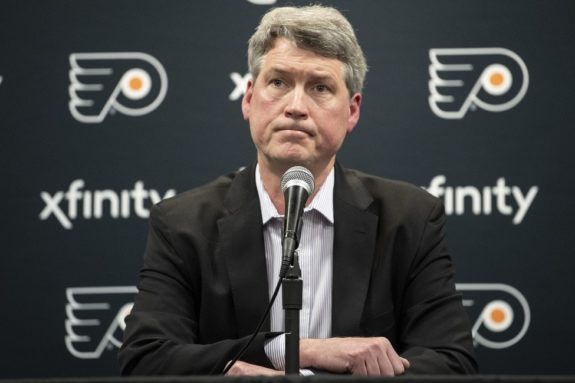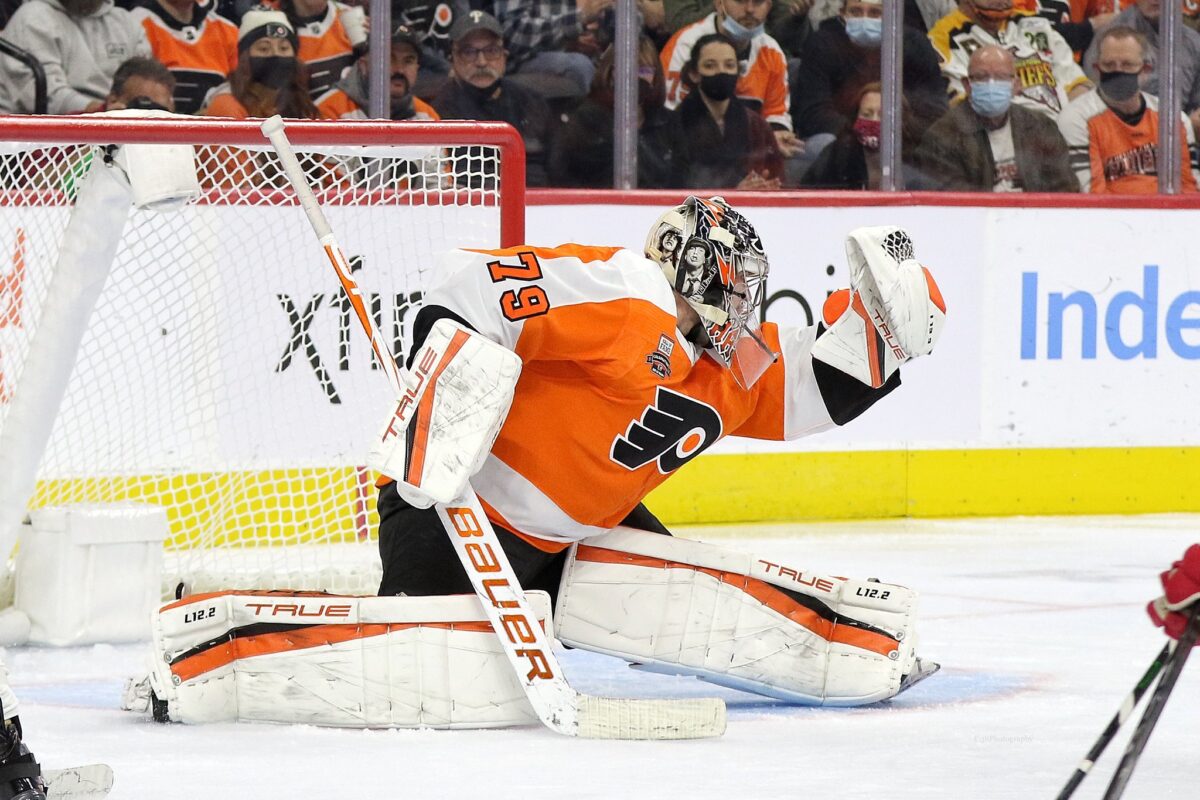The Philadelphia Flyers entered the 2021-22 season looking to avenge the disappointment of the shortened 2020-21 season using an overhauled roster that was supposed to correct their shortcomings. Their sudden freefall in the first half of the season cost Alain Vigneault his job in December, and the team continued to plummet to the basement of the Metropolitan Division under interim coach Mike Yeo. They will miss the playoffs in consecutive seasons for the first time since 1992-93 and 1993-94.
General manager (GM) Chuck Fletcher already boldly revealed his intention to “aggressively retool” the roster. His words during a January press conference spurred conversation about the future of the franchise and the best way to project the timeline of their expected improvement. The intention to retool implies upcoming moves intended to help the team compete in 2022-23, and many fans and media members feel that a more long-term rebuild is necessary to correct the root of the franchise’s issues.
The Flyers face an even more complicated predicament, however. Their path to reenter Stanley Cup contention won’t fit easily into either of the arbitrary terms of classification for roster construction strategy that rarely encapsulate the state of any organization.
Flyers Hope to Retool
Fletcher faces an uphill battle if he hopes to make offseason changes that will help the Flyers make the playoffs next season and compete for a Stanley Cup any time in the near future. Their reported plan for the aggressive retool involves shopping younger players with trade value, shedding the expensive contract of James van Riemsdyk, utilizing a premium draft pick on a player who can contribute in the short term, and chasing some of the top available names on the market.

The plan to retool contains a fatal flaw: Fletcher already tried it last offseason. His roster shuffle included the use of the organization’s assets to acquire veterans who immediately filled team needs. He brought in Cam Atkinson, Ryan Ellis, Rasmus Ristolainen, and Keith Yandle in moves that graded out well during the summer of 2022 because of their apparent fits on the roster. The overall strategy failed about as badly as anyone could’ve anticipated for reasons both within and beyond Fletcher’s control.
The hope for immediate contention also came with a gamble of major financial investments committed to high-priced veterans. The commitments limit the financial flexibility Fletcher will have this offseason in trying to acquire impactful players.
Charlie O’Connor addressed six key concerns that Fletcher will need to solve if the strategy to retool will lead the Flyers into contention in 2021-22 (from Why Flyers’ promised “aggressive retool” is shaping up to be a near-impossible task, The Athletic, 4/18/22). Veteran players returning fully healthy from injuries, the acquisition of at least two top-end players, significant growth from younger players on the roster, the implementation of a new and effective coaching staff, the emergence of a new leadership group, and salary cap wizardry would all need to occur simultaneously. His long, complicated list sounds like an astronomical parlay bet that proves useless if only five of six legs hit.
The situation the Flyers face with Ellis might be the most unlikely wild card of the whole plan. The former Nashville Predators blueliner played four games in 2021-22, and the lack of transparency surrounding his injury problems has led to serious doubt about his future in Philadelphia.
The greatest weakness of the Flyers’ rosters over the past two seasons has been the lack of top-pair defensemen. The acquisition of Ellis was supposed to provide the ideal partner for Ivan Provorov, who struggled to carry the top pair in 2020-21. His absence further exposed the underwhelming Philadelphia blue line, which is unlikely to improve without its expected top right-handed piece next season.
Should the Flyers Rebuild?
Fletcher and Dave Scott, CEO of Comcast Spectacor, sat at the podium in January and rejected the idea of attempting a “three, four, five-year rebuild” before contention becomes an option. They have no intention of moving on from skilled veterans for the purpose of “bottoming out” and eventually earning better draft capital.
“We’re not going to trade all 20 players on our team and try to get 15 picks every year. I don’t think that’s the right approach,” Fletcher said.
Factions of the Flyers fan base disagree with the denial of a long-term rebuild as a necessity. They see the recent failure of the organization as a problem that can’t be tweaked, and they want a clean slate. However, the notion of a full-scale rebuild as a fresh start cannot be applied to all struggling organizations in professional sports because each organization possesses a unique set of circumstances.
Related: 5 Reasons Why Tanking for Shane Wright May Not Be Worth It
In the case of the Flyers, the financial commitments won’t allow for a full-scale rebuild. Their current roster has six players with at least eight seasons of NHL experience signed to contracts with an average annual value (AAV) of over $5 million. Atkinson, Ellis, Ristolainen, Kevin Hayes, and Sean Couturier all have significant term left on their respective contracts. van Riemsdyk has just one.
The decision to pursue a long-term rebuild also requires a leap of faith similar to the long list of requirements Fletcher will need to execute for the retool to succeed. My analysis of the flawed idea of “tanking” includes five variables that aren’t addressed by the incredibly oversimplified assumptions that intentionally abandoning the competitive balance of the NHL will eventually lead to acquiring superstar players who will lead a franchise to a Stanley Cup.
- Players don’t tank.
- Bad teams wait at the mercy of luck in the NHL Draft Lottery.
- The unpredictable nature of player development in the NHL
- The need for roster construction beyond superstars
- Instances of NHL franchises who did further damage by attempting to rebuild
The call for a rebuild from some Flyers fans is directly related to the strategy of their fellow building tenant at the Wells Fargo Center, the Philadelphia 76ers, who made perhaps the longest commitment to tanking in professional sports history from 2013-2017. While the intriguing concept has some benefits in theory, it ignores the magnitude of the time commitment and the potential for a long-term rebuild to put a franchise in an even worse position. A further slip toward irrelevance in the short term is not something the Flyers should consciously pursue.
Fletcher’s Dilemma
Fletcher also emphasized the need for “top-end talent” as a major part of the aggressive retool. Stanley Cup favorites like the Tampa Bay Lightning and the Colorado Avalanche feature rosters with the type of excellent skill players who simply aren’t present on the Flyers roster. How can they fill the void?
“The easiest way to get top-end talent is through the draft. Historically, that’s been proven year after year,” Fletcher said in January.

If the Flyers don’t plan on bottoming out and stripping the roster of their most capable veterans, they are less likely to pick at the top of the draft. If they plan on being aggressive this offseason, they will likely need to move even more draft picks than the 2021 first-rounder, 2022 second-rounder, and 2023 second-rounder they traded last summer as part of Fletcher’s plan for immediate contention in 2021-22.
How do they expect to acquire top-end talent if their plan doesn’t involve acquiring better draft picks?
“We need to take advantage of the opportunities we do have in the draft. We have to look at trades, and obviously, you can always supplement your roster through free agency,” Fletcher added.
The abysmal 2021-22 season does guarantee the Flyers a favorable first-round draft pick this summer, and a large part of their future will ride on that pick. However, an aggressive strategy to acquire more successful NHL veterans might do further damage to the already bleak salary cap situation. It also might hurt the organization’s stock of draft capital if those veterans are acquired through trades. The failure of an unlikely aggressive attempt to contend in the short term could result in an even less likely probability of the success of a future long-term rebuild, which is always incredibly difficult to begin with.
Hope for the Future
In short, the outlook on the Flyers is as bleak as it’s ever been. They are every bit as bad as their record indicates. They can try to point to injuries as a factor outside their control that hurt the team this season just like they pointed to the obstacles of COVID-19 as a cause for their failure in 2020-21. It won’t change the reality that neither of the arbitrary models of retooling or rebuilding applies to the individual predicament they currently face.
A scenario in which neither strategy is deployed is not out of the question. If Fletcher does not make aggressive long-term investments this offseason, the team very well might just perform poorly again in 2022-23 by its own merit. At that point, the Flyers would theoretically pick towards the top of the first round in consecutive years without a firesale of any capable veterans.

The hypothetical scenario would eliminate the need to risk long-term disadvantages by moving van Riemsdyk’s contract or investing money in high-priced NHL veterans from outside the organization in the chase for top-end talent. Fletcher and assistant GM Brent Flahr have also publicly praised the depth of the 2023 draft class.
The Flyers have other reasons to be hopeful. Their most valuable building block is in place at the most impactful position in the sport. Goaltender Carter Hart rebounded from a disastrous 2020-21 season and posted a solid effort in the crease in 45 games in 2021-22. Continued progress could jolt the 23-year-old into the mix with the top netminders in the NHL within the next few seasons.
Flyers fans should also feel good about the development of some pieces in place even if they don’t satisfy the need for top-end talent. Cam York and Bobby Brink look like they can become full-time NHL players next season, and Joel Farabee is a talented young player who will continue his seasoning throughout the tenure of his contract through 2028.

The unpredictability of draft lottery odds, player development, and the NHL landscape at large could also play into Philadelphia’s favor in ways that have benefitted other organizations in the past. Fletcher didn’t know that Kirill Kaprizov would score over 100 points for the Minnesota Wild when he selected the Russian in the fifth round in 2015. The New York Rangers didn’t know Adam Fox would become a Norris Trophy winner when he fell into their laps after he finished his NCAA career.
The state of an NHL organization isn’t always quite what it seems. However, the past 47 years of Flyers hockey aren’t inspiring much positivity within a restless fan base that has watched their team’s gradual slip out of prominence. The disappointment of the past and the bleak outlook on the present will only hurt their perception of the long odds that the Flyers can improve and contend in the future.
